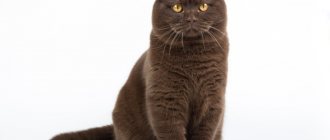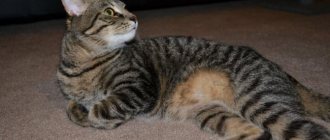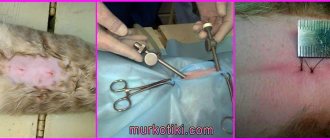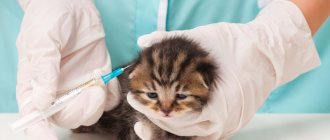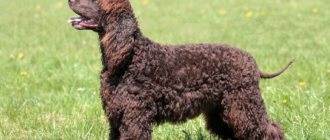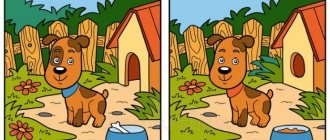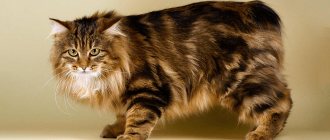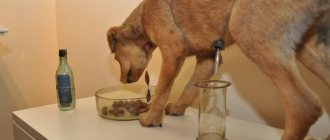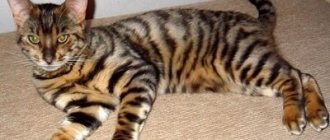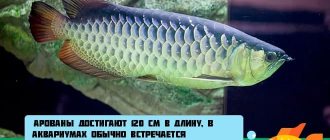The Scottish Fold is a young cat breed. The first kittens appeared a little over 50 years ago - in the 60s of the 20th century. Animals with folded ears quickly fell in love with buyers, first conquering Europe, and then moving to the United States.
One of the features due to which the black fold-eared cat has become the favorite of a large number of people is its straight stance. Imitating gophers, these animals like to sit on their hind legs, raising their body, and lowering their front legs. Only their goals are different - this is how the animals knead the bones of the spine.
Surprisingly, although the black fold cat belongs to the cat family, in most cases he is afraid of heights. This feature is due to the structure of the vestibular apparatus. But when playing, they do not jump on the curtains and rarely jump on cabinets. Fold-eared Scots love to play and fool around, but they will do it with dignity.
Story
The first animal of this breed, Susie, appeared in Scotland from a semi-wild cat. The father remains unknown.
Quite early, Susie began to bear offspring, which the owners had difficulty placing with friends. In 1963, a resident of Scotland, Mary Ross, received one of Susie's kittens as a gift - it was a white cat, nicknamed Snooks. Her first offspring revealed a kitten very similar to those we know today as Scottish Folds. It was a white cat with heavy paws, who was named Snowball. The owner did not have the skills of a breeder, but the woman thought that she had a chance to see the birth of a new breed.
After Snowball grew up, he was crossed with a British Shorthair. At the same time, in the next mating, Snooks was bred with a British blue. It was in this simple way that the first Scottish Fold cat was obtained at home. The black color of the first litter and folded ears attracted the interest of the breeders, who helped Mary develop the final breeding algorithm.
Over the past few decades, this breed has become one of the most sought after throughout the world. As a result of a malfunction in the gene pool that arose due to crossbreeding with short-haired cats, geneticists had to make a lot of effort to eliminate it. If both parents were lop-eared, such crossing sometimes led to disorders in the musculoskeletal system. This is what forced the use of partners of the Scottish breed who do not have folded ears in breeding.
The fold-eared black cat most often appears with normal ears. They fold only after four weeks after birth.
Genetics of black color
The black Scottish Fold cat, as well as the straight-eared cat, have a special gene that gives this coat color. This is a gene of the black series, which is designated by the letter B. But since there is always a pair of genes in the set, the black color gene can be presented in the homozygous state BB or in the heterozygous state, for example, Bb (a cat or cat that has a black color, but is a carrier chocolate color gene).
In order for a cat to be like a piece of coal, the B gene is not enough. In addition to it, the cat must also have the color density gene D (in the homozygous form DD or in the heterozygous form - Dd). If a cat has a set of genes not DD or Dd, but dd (d is a diluent gene), then it will force the color pigments inside the hairs to group differently - and the cat will be blue (gray), because gray is the same black, only diluted, or rather, regrouped differently.
There are a number of other genes that help either to form a solid black color, or to create other colors based on the black series gene. But this is the topic of a separate article devoted to genetics. Here we provide only basic knowledge.
Appearance
Light blue coat color is considered classic. But since a large number of different exotics took part in the formation of the breed, today a huge variety of colors is acceptable. Scots can be blue, cream, white, bicolor, black, tabby, chinchilla and so on.
The head of animals of this breed is round, with a flat forehead, drooping ears. The legs are relatively short, the paws are rounded. The nose is straight and wide. The fur is short and thick.
On average, a black fold cat weighs 8 kg.
Colors of Scottish Straight cats
There is no difference in coat color variations between Scottish Straights and Folds. Cats with straight ears come in exactly the same colors as their fold-eared relatives:
- plain;
- bicolor;
- point;
- tipping;
- tabby
Similarly with the long-haired “Scots” (Highland Fold and Highland Straight), they are also characterized by all of the listed colors.
INTERESTING! As Scottish kittens grow, the color of their coat gradually changes. The final color is formed when the animal reaches 2 years of age.
The most popular are smoky, chinchilla, single-color, tortoiseshell, and shaded representatives of the straight-eared Scottish variety.
Intelligence
Animals are playful and quite active - this is especially true for kittens. They quickly get used to sitting in their owner's arms. The black fold cat is prone to basic training. These animals quickly figure out what purpose there is a scratching post in the house; some individuals are able to turn on and watch TV.
The intelligence of Scottish Folds is at a fairly high level, their intuition is well developed, and they are highly adaptable. These animals are able to quickly get used to any environment, “read” the owner’s emotions, adapting to his mood. Fold-eared pets are non-aggressive, they are almost unable to take revenge.
Interesting facts about Scottish Folds
- The Scots are afraid of heights. Due to a weak vestibular system, they become disorientated when away from the ground.
- Because of their round cheeks, cats seem to smile a little.
- Cats like to sit on their butts with their hind legs extended forward and their front legs placed on top.
- The first mention of the fold in the USSR was in the cartoon “Carlson”. The cat Matilda is a representative of this breed.
- The breed is still not recognized in the country of origin.
Scottish Folds are the easiest breed to care for. They are peaceful, sweet and loyal. If you want to get a calm, loyal friend, then these cats are best suited.
Character
The character of these animals is very stable, they do not give in to hysterics, quickly become attached to the house and owner, while being self-sufficient.
A striking feature of the breed is its voice. It does not at all resemble a gentle purr, but rather the creaking of old wood. Scots rarely shout, mostly communicating their needs in a polite manner.
In conflict situations, ordinary cats hiss, bite, and show aggression in every possible way. However, this does not apply to the Scots, who are born diplomats. If they could go to work, they would certainly get into politics!
Socialization
These animals get used to their family extremely quickly. Experienced owners are sure that cats treat children and elderly family members with special tenderness. If they really like a person, they will follow him everywhere, trying to attract attention. However, no matter how much they want to socialize, they will not distract from business by grabbing your legs or jumping on your lap. The most important thing for these cats is to be close to their loved one.
Other animals, including cats, please the Scots as they love good company. Even living together with a dog does not spoil the cats’ mood - they quickly get used to such a neighbor, playing with him and even caring for his fur.
Peculiarities
The high intelligence of cats of this breed indicates their good learning ability, however, screaming can forever discourage the animal from obeying. Moreover, a cat can become aggressive and cowardly if you shout at it regularly.
Fold-eared Scots do not tolerate rudeness. So, it will not be possible to carry cats of this breed by the scruff of the neck - they simply will not allow it. Firstly, because due to their severity, this position is painful for animals. Secondly, it is harmful to the spinal column. Cats need to be carried in such a way that all paws can rest on something in the air.
The owner must be extremely patient to raise a Scotsman. It is important to understand the individual characteristics of cats. For example, remember that even the smartest animal is not able to remember several commands. It is necessary to move from simple to more complex exercises.
Folk beliefs about the black cat
From time immemorial, people have seen something mystical in black cats, considered them animals of magicians, and some attributed bad qualities to them and came up with signs like “expect trouble if a black cat crosses the road.” It is not surprising that even Bulgakov’s devilish cat Behemoth in “The Master and Margarita” was black.
Astrologers also came up with their own description of black cats. So, they believe, black Capricorn cats are under the influence of the planet of loneliness Saturn, which means that it is better not for single women who want to find a mate to have them. And, for example, a black cat born under the sign of Pisces will give its owner the ability to see prophetic dreams and perform magical rituals.
Esotericists who believe in the supernatural believe that black cats provide protection from negative energy. Whether this is true or not really doesn’t matter. If you believe in this, then the defense will work, because then you will radiate confidence - and all misfortunes will bypass you.
Care
Most breeders talk about the low whimsical nature of cats of this breed. Their fur must be brushed daily with a massage brush. Animals get used to this quite quickly, enjoying the procedure that is beneficial for their health.
The fold-eared black cat, whose photo will decorate any catalog of breeds, contrary to stereotypes, does not resist bathing. Often gets used to water procedures after three to five times. Despite this, you can wash it only if absolutely necessary - if fleas appear or there is significant contamination.
The unique shape of the ears leads to the rapid accumulation of dust and wax in them. Therefore, you should inspect them regularly - 2-3 times a month. When cleaning, use a cotton swab coated with ear hygiene liquid.
Animals need to trim their claws no more than once a month - for this you should buy a steel nail clipper and a scratching post. The claw must be trimmed by 2 mm. You should not use scissors - this can harm the animal’s nerve endings or fingers.
How to choose a Scottish Fold kitten
Kittens are taken from breeders at the age of 2.5-4 months. By this time they are sufficiently formed, trained and already vaccinated. From the mother he received immunity and the first skills for later life.
When choosing a kitten, you should pay attention to plump, active and friendly babies. The color should be uniform, it is quite natural if the color is a little pale compared to an adult cat. With age, the color of the coat and eyes will become brighter. The ears won't change.
It is better to take kittens from trusted, experienced breeders or from breed nurseries. Otherwise, it is fraught with health problems in the future.
The cost of kittens starts from 10,000 rubles and ends at 55,000 – 57,000 rubles. It all depends on whether you need a champion offspring for breeding or just a family friend.
Nicknames
Many owners, having acquired a new pet, are tormented by the question of what to name a fold-eared (black) cat. First of all, you should take into account that purebred animals have pedigrees and breeder marks. Each kitten is registered, so all animals from the same litter must have names starting with the same letter - this narrows the list.
The Scottish Fold (black) cat can be named anything, but most owners still prefer beautiful, sonorous nicknames that will sound good at exhibitions. For a home, purebred animals most often have a simpler, shorter and more convenient name. For example, King all Round at home may well turn out to be Bantik.
Price
The cost of a kitten depends on a number of factors - primarily pedigree, necessary documents, hereditary diseases and habits. There are several classes of pedigree kittens.
- Show class is the elite of this breed. Parents participated in exhibitions and received awards. The cost of such a copy is from 1200 to 2500 euros.
- Breeds are proven healthy babies with a decent pedigree and documents. Allowed for exhibitions. The price ranges from 500 to 1000 euros.
- Pets are purebred pets that were disqualified from participation in exhibitions for minor reasons and are not allowed to breed. This is the best choice if you just want to have a furry pet at home and don’t need a show piece. The average price for a Scottish Fold in this category in nurseries ranges from 100 to 500 euros.
It is advisable to choose well-known nurseries and trusted breeders. Do not try to buy on sales sites, although the cost there may be lower. You must receive a guarantee of purebredness and health. Even if it's a little more expensive. There are nurseries in Russia that breed these cats. For example, in Moscow Ermine Trace.
Diseases
Owners need to take care of the health of a cat prone to longevity. Despite the fact that the average lifespan of a lop-eared cat is 19 years, you need to regularly take them to the veterinarian and monitor their well-being at home.
First of all, you should monitor the cat’s appetite, sociability and behavior. If there are warning factors, it is necessary to check the temperature, take the pulse, and pay attention to other symptoms. If something bad happens to your animal, you should immediately consult a doctor.
Caring for black Scottish cats
Black cats are not easily soiled, so if the floors in your apartment suddenly become dirty, you won’t be able to see it from a black cat, unlike a white one.
You can comb a black cat with any comb or other device that does this well.
Cats are bathed with professional shampoos that enhance the black color and add shine. This is relevant, first of all, for show animals. However, if your pet does not participate in exhibitions, but you are very picky about its appearance, we also recommend purchasing a special professional shampoo. Moreover, it allows you to maintain the microbiome (microflora) of the cat’s skin in the desired form.
Black Highland Fold cat
It is worth making sure that the cat receives enough vitamins and minerals from food - then the coat will shine. If a cat does not receive enough trace elements, in particular the amino acid tyrosine, which is involved in the synthesis of the eumelanin pigment (black pigment), the coat fades. Tyrosine is contained in meat, so not only for health, but also for the quality of color, the basis of the Scottish cat’s diet should be this product. Otherwise, the fur will take on a reddish, rusty tint.
You should not allow your pet to be exposed to sunlight for long periods of time to prevent the fur from fading.
